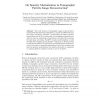Free Online Productivity Tools
i2Speak
i2Symbol
i2OCR
iTex2Img
iWeb2Print
iWeb2Shot
i2Type
iPdf2Split
iPdf2Merge
i2Bopomofo
i2Arabic
i2Style
i2Image
i2PDF
iLatex2Rtf
Sci2ools
DAGM
2008
Springer
2008
Springer
On Sparsity Maximization in Tomographic Particle Image Reconstruction
This work focuses on tomographic image reconstruction in experimental fluid mechanics (TomoPIV), a recently established 3D particle image velocimetry technique. Corresponding 2D image sequences (projections) and the 3D reconstruction via tomographical methods provides the basis for estimating turbulent flows and related flow patterns through image processing. TomoPIV employs undersampling to make the high-speed imaging process feasible, resulting in an ill-posed image reconstruction problem. We address the corresponding basic problems involved and point out promising optimization criteria for reconstruction based on sparsity maximization, that perform favorably in comparison to classical algebraic methods currently in use for TomoPIV.
DAGM 2008 | Ill-posed Image Reconstruction | Image Processing | Image Reconstruction | Tomographic Image Reconstruction |
| Added | 19 Oct 2010 |
| Updated | 19 Oct 2010 |
| Type | Conference |
| Year | 2008 |
| Where | DAGM |
| Authors | Stefania Petra, Andreas Schröder, Bernhard Wieneke, Christoph Schnörr |
Comments (0)

